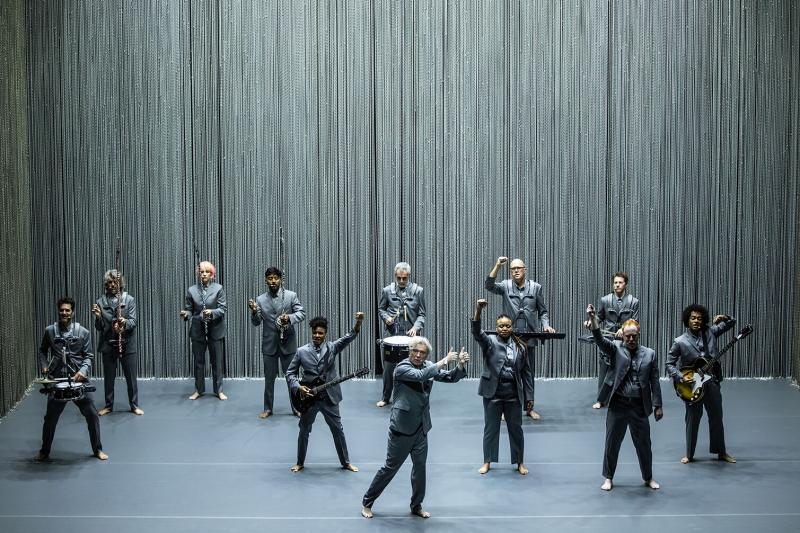Review: DAVID BYRNE'S AMERICAN UTOPIA, A Call To Reject Complacency
As Maira Kalman's illustrated curtain rises for David Byrne's choreographed concert, which takes its name from his 2018 album, American Utopia, the singer/songwriter/guitarist is seriously contemplating the human brain. Specifically, his recently-acquired knowledge that that the abundance of neural connections in an infant's brain decreases significantly as the tyke grows into adulthood.

Tendayi Kuumba and Stéphane San Juan
(Photo: Matthew Murphy)
"Does this mean babies are smarter than us, and we get stupider as we grow older?" he contemplates. Or perhaps it's that our desire for fresh stimulation grows less useful as we settle into the everyday rhythms of our lives.
If there's a connecting theme to this 100-minute performance, and seriously, this reviewer isn't sure that there is, it may lie within the dangers of human complacency. By the end of the evening, he's talking about how the traditionally low Election Day turnouts among Americans result in the minority of citizens demonstrating the ability and the desire to cast their votes making decisions for the majority who either can't or just don't.
At this point readers show be advised of the possessor of this byline's limited exposure to the award-winning member of the Rock and Roll Hall of Fame's career, Though he immensely enjoyed Byrne's Imelda Marcos bio-musical HERE LIES LOVE (and less enthusiastically endured his stage follow-up ,JOAN OF ARC: INTO THE FIRE), all other details, including his initial fame as lead singer and guitarist for the new wave band Talking Heads, was acquired by Googling.
On a bare stage, surrounded on three sides by curtains of linked chains, the star performs with an ensemble of eleven. Two of them, the charismatic pair Chris Giarmo and Tendayi Kuumba, are there primarily to sing and perform Annie-B Parson's choreography. The rest, under the co-music direction of Karl Mansfield and Mauro Refosco, make up the percussion-heavy orchestra.
Everyone is dressed in a uniform of bare feet and silvery gray suits. There are no credits for set and costume design, but Broadway director Alex Timbers is credited as production consultant.
It's rather refreshing to see a stage concert like this performed with no video screens or flashy set pieces. Even Rob Sinclair's lighting design is predominantly stark and clean, only occasionally delving further into textures.
Pete Keppler's sound design works solely with individual body microphones so, as Byrne explains, to put nothing the way between the connection between those onstage and those in the audience.
The set list is made up only partially of songs included on the American Utopia album, including, "Everybody's Coming to My House," "Every Day Is a Miracle," "Here," "Bullet" and "I Dance Like This." The rest of the show is taken from his previous hits and favorites.

Gustavo Di Dalva, Angie Swan, Stéphane San Juan,
David Byrne, Tendayi Kuumba, Karl Mansfield, TimKeiper,
Chris Giarmo and Bobby Wooten III
(Photo: Matthew Murphy)
His music is a pleasing, minimalist assortment of world sounds, and the Scottish-born American citizen is proud to point out the diverse national heritages of the artists who share the stage with him.
Byrne is usually front and center, sometimes performing amusingly low-key hipster dance moves, with his castmates creating formations and executing angular unison movements. There's the sense of community on the stage, with Byrne as the guiding elder.
But the stylized nature of the show is abandoned for a moment, with a determined ensemble performance of Janelle Monae's protest anthem "Hell You Talmbout," a call-and-response song urging listeners to repeat the names of innocent black Americans, from Emmett Till to Atatiana Jefferson, killed under the guise of law enforcement.
While this neophyte to David Byrne's work found American Utopia to be an entertaining, sometimes moving, change of pace from his typical Broadway assignments, he'll defer to his Byrne-loving theatre companion who found the evening absolutely thrilling. Judging from the audience's response, she wasn't alone.
Reader Reviews



